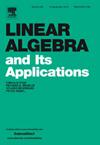On matrices in finite free position
IF 1.1
3区 数学
Q1 MATHEMATICS
引用次数: 0
Abstract
We study pairs of square matrices that are in additive (resp. multiplicative) finite free position, that is, the characteristic polynomial (resp. ) equals the additive finite free convolution (resp. the multiplicative finite free convolution ), which equals the expected characteristic polynomial (resp. ) over the set of unitary matrices U. We examine the lattice of (non-irreducible) affine algebraic sets of matrices consisting of finite free complementary pairs with respect to the additive (resp. multiplicative) convolution. We show that these pairs include the diagonal matrices vs. the principally balanced matrices, the upper (lower) triangular matrices vs. the upper (lower) triangular matrices with constant diagonal, and the scalar matrices vs. the set of all square matrices.
在有限自由位置的矩阵上
我们研究了方阵对(A,B),它们是可加性的。乘性)有限自由位置,即特征多项式χA+B(x) (resp。χA(x) =加性有限自由卷积χA(x) χB(x) (p. x)。乘性有限自由卷积χA(x)⊠χB(x)),它等于期望的特征多项式EU[χA+U BU(x)]。EU[χAU BU(x)])在酉矩阵集合u上。我们研究了由有限自由互补对组成的矩阵(不可约)仿射代数集的格。乘法)卷积。我们证明了这些对包括对角矩阵与主平衡矩阵,上(下)三角矩阵与上(下)三角矩阵具有恒定对角,标量矩阵与所有方阵的集合。
本文章由计算机程序翻译,如有差异,请以英文原文为准。
求助全文
约1分钟内获得全文
求助全文
来源期刊
CiteScore
2.20
自引率
9.10%
发文量
333
审稿时长
13.8 months
期刊介绍:
Linear Algebra and its Applications publishes articles that contribute new information or new insights to matrix theory and finite dimensional linear algebra in their algebraic, arithmetic, combinatorial, geometric, or numerical aspects. It also publishes articles that give significant applications of matrix theory or linear algebra to other branches of mathematics and to other sciences. Articles that provide new information or perspectives on the historical development of matrix theory and linear algebra are also welcome. Expository articles which can serve as an introduction to a subject for workers in related areas and which bring one to the frontiers of research are encouraged. Reviews of books are published occasionally as are conference reports that provide an historical record of major meetings on matrix theory and linear algebra.

 求助内容:
求助内容: 应助结果提醒方式:
应助结果提醒方式:


